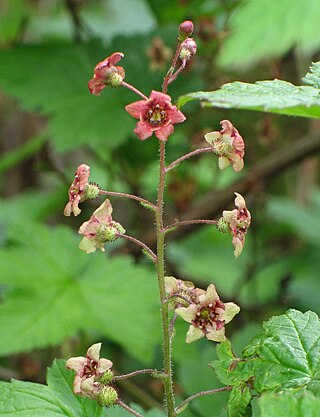Top Qs
Timeline
Chat
Perspective
Ribes laxiflorum
Species of currant From Wikipedia, the free encyclopedia
Remove ads
Ribes laxiflorum is a species of currant known by the common names trailing black currant, and spreading currant.[2] It is native to western North America.
Remove ads
Description
Ribes laxiflorum is a spreading, trailing shrub usually growing .5–1 metre (1+1⁄2–3+1⁄2 feet) in height. It has been known to take a somewhat vine-like form in appropriate shady habitat with nearby supports, climbing to 7 m (23 ft) in length.[3] It has fuzzy, glandular stems lacking spines and prickles. The hairy, green leaves are up to 10 centimetres (4 inches) wide, divided into 5–7 lobes lined with dull teeth; the undersurfaces are glandular.[4]
The inflorescence is a mostly erect raceme of up to eight flowers. The distinctive flower has five greenish, purplish, or red sepals which are often curved back at the tips. At the center is a corolla of five red or pink petals each measuring 1 millimetre (1⁄32 in) long, narrow at the base and wider or club-shaped at the tip. Inside the corolla are five red stamens tipped with whitish anthers. The fruit is a purple-black berry measuring 4–14 mm (3⁄16–9⁄16 in) wide which is waxy, hairy, or bristly in texture.[3]
Remove ads
Distribution and habitat
It is native to western North America from Alaska and Yukon south as far as northern California and New Mexico;[5] it has also been found in Siberia. Its habitat includes moist mountain forests, clearings,[4] streambanks, and the borders of mountain roads.
Uses
The berries are considered unpalatable raw[4] but are eaten locally (variously fresh, boiled, or as preserves) by Bella Coola, Haisla, Hanaksiala, Hesquiat, Kwakiutl, Lummi, Makah, Oweekeno, Skagit, and Tanana peoples.[6]
Other traditions use R. laxiflorum for an infusion to make an eyewash (roots and or branches, by the Bella Coolah).[6]
Decoctions of: bark to remedy tuberculosis (with the roots, by the Skokomish); or for the common cold (Skagit): leaves and twigs, as a general tonic (Lummi).[6]
Woody stems are fashioned into pipe stems (Hesquiat).[6]
References
External links
Wikiwand - on
Seamless Wikipedia browsing. On steroids.
Remove ads


